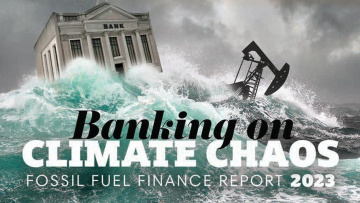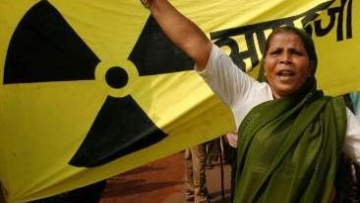
Project – On record
This profile is no longer actively maintained, with the information now possibly out of dateBankTrack
Jan Haverkamp, Greenpeace International, Belgium
Jan Beranek, Greenpeace International, Netherland
Project – On record
This profile is no longer actively maintained, with the information now possibly out of dateBankTrack
Jan Haverkamp, Greenpeace International, Belgium
Jan Beranek, Greenpeace International, Netherland
What must happen
Any of the banks approached should not finance the Jaitapur nuclear power plant project directly or indirectly through general funding to NPCIL.
| Sectors | Nuclear Electric Power Generation |
| Location |
|
The Jaitapur project plans to host two European Pressurised Reactors (EPRs) of 1,650 MWe each, with possible extension by four additional units. The Generation III+ class EPR has been designed and developed by the French company AREVA.
A coalition of environmental and citizen groups is calling on European banks and decision-makers not to provide their support and participation in this and similar projects. Facts about nuclear safety, local oppression, approval procedures, institutional frameworks and project economics strongly indicate the application of double standards when compared to what is common and required in European countries.
Social and human rights impacts
Destruction of local farming and fishing
The official report by NPCIL says that the plant's heating water outlet could increase sea temperature in the area by 5 degree C. However, environmental consultant P R Arun claims that released water would affect the entire food chain and decimate the fish catch and obviously impact seriously the livelihoods of people associated. Even small quantities of hot water can destroy marine life, as was observed near the Tarapur (Mumbai) atomic power station.
In fact, half a degree increase in the temperature will be detrimental for the sensitive species. One example is the prawn, which is an highly economically important fishery resource. Nearly 6,000 people depend on fishing in the area and more than 10,000 benefit indirectly. Twelve villages in the vicinity have an annual income of 150 million INR (€ 2.5 million) from fishing.
The district is also a recognised horticulture zone, with many farms growing mango (the internationally famous Ratnagiri Alphonso variety), cashew and jackfruit for export. As a direct result of the project, 770 families would lose their land entirely and another 150 families would lose part of their farming land.
Human rights violation
Since a nuclear power plant at Jaitapur was proposed in February 2009, there have been protests against the plants by the local population, farmers and fishermen. Between December 2009 and January 2010, officials of NPCIL acquired 938 hectares of locally-owned lands for setting up what is proposed as the world's biggest nuclear power plant. The compensation offered was as low as 3 INR (5 eurocents) per square metre. It was rejected by local people, who argued that they did not want to give away their land. Their protest was suppressed by police who beat and arrested hundreds of villagers.
Environmental and climate impacts
Valuable ecosystem
A comprehensive carrying capacity analysis, which should assess the ability of the ecosystems in the region to carry the burden, has not yet been carried out, despite a request by the Ministry of Environment and Forestry. The area is part of an important and intact mangrove ecosystem, with dozens of species living in the district concerned. Field studies have revealed that the mangroves of this region are significantly threatened, with several species recorded as endangered and/or critically endangered. The narrow strip of land between the coastline and the Western Ghats mountains is recognised as being environmentally sensitive. Its grasslands play an important role for maintaining freshwater reservoirs and preventing sea water ingress. The area provides a suitable habitat for wild animals such as leopards, white-bellied sea eagles, wild cats, hares and jungle fowl, and gaurs and elephants have also been observed.
Other impacts
Earthquake zone
India is divided into four types of seismic risk zones by the Indian standard code, IS 1893 (‘Criteria for earthquake-resistant design of structures’). Jaitapur is located in one of the ‘high-risk zones’, classified as Zone IV, meaning that it is prone to strong earthquakes.
The Jaitapur area is transversed by three tectonic faults. A number of earthquakes have been recorded here in the last 20 years alone, with the strongest - in 1993 - having a 6.3 magnitude on the Richter scale, and with three others exceeding magnitudes of 5.
Nuclear Safety
During recent construction projects in Olkiluoto in Finland and Flamanville in France, a number of technical and safety problems have been identified with the EPRs, such as heavy interconnection between safety and instrumentation digital systems that may lead to their failure, or questionable ability to withstand impact by an airliner. Serious defects in the quality of components, as well as welding and construction work, have also occurred at both sites.
The Finnish safety agency STUK recorded over 3,000 safety and quality problems with EPR construction. It has been recognised that these problems occurred because attempts to reduce costs led the company to select cheap, incompetent subcontractors and overlook safety-related problems. In addition, nuclear safety training was not provided to workers. In France, inspections repeatedly mentioned that the problems arose from “haste without any quality assurance process”.
The pressure to keep the EPR cost very low in India could cause even larger problems with cutting safety corners and poor quality of construction than we have seen in France and Finland. The cost of the two Jaitapur EPR units is officially estimated at 32,000 crore (€ 5.4 billion). This is less than half of the cost estimates of building the reactors in Europe or Canada. The argument about cheap labour in India cannot explain such a massive price discrepancy, as most of the price comes from engineering equipment and heavy components.
In addition, EPR reactors are inherently harder to build and control because of their larger size and the fact that they are designed to use high fuel burn-up, which places higher requirements and stricter standards on the quality of their construction. In contrast most Indian reactors built to date have been units up to eight times smaller (220 MWe), with just two coming close to even one-third (540 MWe) of the size of an EPR (1,650 MWe).
Last but not least, the lack of independence of the Indian nuclear safety authorities can result in many possible problems not being detected or with their corrections not being sufficiently enforced.
India’s weak regulatory environment
a) Not a member of Non-Proliferation Treaty. India is a country that has never joined the Non-Proliferation Treaty. It is known to use many of its nuclear facilities for dual purposes, i.e. for both energy production and the fabrication of fissile materials for military use.
b) No independent regulator authority for nuclear safety. The 1962 Atomic Energy Act established the Department of Atomic Energy (DAE) as the body responsible for nuclear energy. This department directly operates a number of nuclear facilities in India. In 1983, the DEA established the Atomic Energy Regulatory Board (AERB) as the entity in charge of nuclear regulation. It reports to the Atomic Energy Commission (AEC). This arrangement means that the AERB lacks any independency, because members of the AEC include three institutions actively involved in nuclear business: the Secretary of the DAE, the Director of the Baba Atomic Research Center, and the Managing Director of NPCIL, which will be the future operator of Jaitapur’s reactors. In contrast, current EU legislation requires that “Member States shall ensure that the competent regulatory authority is functionally separate from any other body or organisation concerned with the promotion, or utilisation of nuclear energy, including electricity production, in order to ensure effective independence from undue influence in its regulatory decision making“ (EU Directive 2009/71).
c) Unresolved responsibility for damage caused by a nuclear accident. Another issue of relevance to the Jaitapur project is the non-existence of any legislation that would deal with liability of nuclear power plants in case of accidents and damage to the public and third parties. The Indian Prime Minister was forced to withdraw a draft liability bill, tabled in Congress in March 2010, due to political outcry. Some of its prominent critics, for example former prosecutor Soli Sorabjee, concluded that the bill was non-constitutional.
Lack of transparency
The 1962 Atomic Energy Act is an outdated piece of legislation, which does not guarantee access to any information. There is no possibility to file a request under the Right to Information Act (adopted in 2005) in order to make information public.
There has also been lack of transparency in public hearings for the project. The first public hearing was organised in August 2006. It was conducted in English despite villagers requesting it in the Marathi language that they speak. “The company did not even provide the EIA report before the hearing,” says Vivek Y Bhide, a practicing doctor and one of local opposition leaders.
Jaitapur N-plant project on hold for now?
Video links
2011
2011-06-08 00:00:00 |
Due to the Fukushima controversy, the project is currently in standby mode. At the moment banks still need to analyse the project, the visits that were supposed to take place in India have been postponed, and no due diligence has been done yet on the project.
Protests are continuing against the proposed power plant and recently one turned violent. On April 18 in the coastal Ratnagiri district one protestor was killed and seven others injured doing a demonstration against the nuclear plant. Around 600-700 locals were involved in the protest.
France and India signed on December 6th, 2010 a General Framework Agreement between French nuclear major Areva and Nuclear Power Cooperation of India Ltd (NPCIL) for building two European pressurised reactors (EPR) in Jaitapur. But some issues, including the price of these reactors and differences over India’s civil nuclear liability law, will have to be sorted out before the commercial contract is executed.

